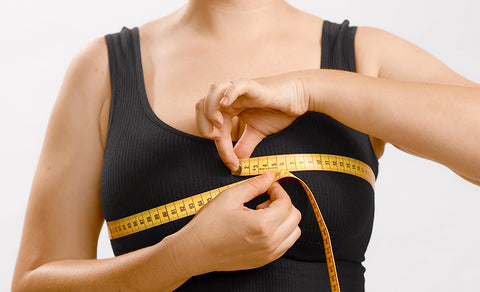Breast shapes are diverse and unique, with no singular "normal" breast shape. Various factors influence breast shape, such as weight fluctuations, exercise routines, age, pregnancy, and breastfeeding.
Understanding different breast shapes and knowing how to measure your bra size can help you find the perfect fit, ensuring both comfort and support. In this article, we will explore the fascinating world of breast shapes, discuss their potential impact on bra selection, and provide a comprehensive guide on measuring your bra size accurately.
Is There a "Normal" Breast Shape?
Breast shape is a highly individual characteristic, and it's important to debunk the notion of a "normal" breast shape. Each person's breasts have their own unique attributes, making them beautiful and special.
Factors like genetics, hormones, and lifestyle choices can influence breast shape. Weight fluctuations can cause changes in breast size and shape, while regular exercise can impact firmness and perkiness.
With age, breasts tend to lose elasticity and firmness. Additionally, the transformative processes of pregnancy and breastfeeding can alter breast shape due to hormonal changes and milk production. Embracing and appreciating the diversity of breast shapes is key to body positivity.
Common Breast Shapes
Breast shapes encompass a wide range of variations, each with its distinct characteristics. Let's explore some of the most common breast shapes:

Round breasts have equal fullness at the top and bottom, creating a circular appearance. They often have a well-defined cleavage and symmetrical shape. This breast shape is often considered versatile and suits a wide range of bra styles.
Best bras: T-shirt bras, balconette bras, and plunge bras that enhance the natural roundness.

Archetypal breasts are considered the "classic" or "ideal" shape. They are round and full, gently sloping from the chest wall to form a natural teardrop contour. Bras with moderate coverage and support tend to work well for this breast shape.
Best bras: Most styles work, but demi-cups and lightly lined bras are particularly flattering.

Tear-drop breasts have more volume at the bottom than the top, resembling a teardrop shape. They are fuller and project forward at the bottom, creating a natural curve.
Best bras: Balconette or demi-cup bras can provide excellent support and enhance the natural shape of tear-drop breasts.

Bell-shaped breasts have more fullness at the bottom and taper towards the top. They resemble the shape of a bell or a ski slope, with a gentle slope from the chest wall to the nipple.
Best bras: Full-cup bras are a great choice for bell-shaped breasts, providing full coverage and support.

Conical breasts are elongated and taper to a point at the nipple. They have less fullness in the upper pole, appearing more cylindrical or cone-shaped.
Best bras: Balconette or plunge bras work well for conical breasts, providing a flattering shape and minimizing the pointy appearance.

Relaxed breasts have a softer and less firm appearance. They may exhibit more sagging or drooping due to factors like age, gravity, or breastfeeding.
Best bras: Full-coverage bras with additional support features can help lift and shape relaxed breasts.

Side-set breasts are positioned wider apart on the chest wall, creating more space between them and a wider cleavage area.
Best bras: Push-up bras with a center plunge can bring side-set breasts closer together, creating a more central and defined cleavage.

Close-set breasts are positioned closer together on the chest wall, with minimal space between them and a narrower cleavage area.
Best bras: Bras with a center gore that sits flat against the sternum can provide comfortable support for close-set breasts.

Slender breasts have a narrow and elongated shape. They are less full and more elongated compared to other breast shapes.
Best bras: Balconette or demi-cup bras can add volume and enhance the shape of slender breasts.

Asymmetrical breasts have uneven size or shape. One breast may be larger or differently shaped than the other, which is common in most individuals.
Best bras: For asymmetrical breasts, wearing a bra with removable padding or using bra inserts can help create a more balanced appearance.

East-west breasts have nipples that point outward, away from the center of the chest. They create a wider appearance when viewed from the front.
Best bras: Bras with side panels and higher side wings can help bring east-west breasts forward, creating a more central and balanced look.

Athletic breasts are characterized by their firmness and lack of significant sagging. They have less fullness and projection due to lower body fat percentage and muscle development.
Best bras: Sports bras with compression or encapsulation features are ideal for athletic breasts, providing support and minimizing bounce during physical activities.
Find Your Match Bra
How to Measure Your Bra Size
Knowing your accurate bra size is crucial for finding a bra that offers optimal support and comfort. Here's a step-by-step guide:
- Measure your band size: Wrap a measuring tape around your torso, just beneath your breasts, ensuring a snug but not tight fit.
- Determine your cup size: Measure around the fullest part of your breasts. Subtract the band measurement from this. Each inch difference = 1 cup size.
- Combine band & cup: For example, band 34 + 2-inch difference = 34B. Try different brands within your size range for the best fit.
👉 Want more details? Check out our guides: How to Measure Bra Size and Find the Perfect Fit & How Breast Root Affects Your Bra Fit.

Final Thoughts
Appreciating the uniqueness of your breast shape is essential for embracing self-confidence and comfort in your own body. There is no "normal" breast shape — each holds its own beauty.
By understanding your shape and measuring your bra size accurately, you can find bras that provide the ideal support and fit. Celebrate your individuality and enjoy the journey of discovering the perfect bra for you.










